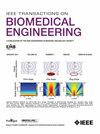High-Resolution Whole-Brain Diffusion Tensor Imaging Exploiting Rapid Single-Slab 3D EPI Strategy
IF 4.5
2区 医学
Q2 ENGINEERING, BIOMEDICAL
引用次数: 0
Abstract
高分辨率全脑扩散张量成像利用快速单板3D EPI策略。
目的:探讨基于物理约束的快速单板三维伪随机EPI编码策略实现高分辨率全脑弥散张量成像(DTI)的可行性。方法:对基于自旋回波的弥散加权成像进行了改进,包括用于高分辨率弥散成像的单平板3D分段EPI和用于特定节段运动诱导相位导航的短读数的非分段EPI。引入了一种物理约束的分段分组相位编码策略,即使在存在磁场不均匀性的情况下,也能产生快速的伪随机空间遍历和平滑的局部邻域信号转换。通过数值模拟和体内研究验证了所提出的高分辨率全脑DTI方法的可行性。结果:即使在存在磁场不均匀性的情况下,所提出的方法也表现出鲁棒的点扩展函数(PSF),并从高度不完整的测量(减少因子= 5.5)中产生DTI参数图的清晰描述。此外,该方法具有鲁棒的PSF、较高的编码效率和较高的信号增益,优于传统的二维单镜头EPI和传统的同步多片EPI。结论:我们成功展示了具有物理约束的快速单板三维伪随机EPI编码策略,该策略可以在大约14分钟内实现高分辨率(1.0mm)单板三维DTI,没有明显的伪影和噪声。意义:这是第一次前瞻性地证明了高分辨率单板全脑DTI的快速,物理约束伪随机EPI策略。
本文章由计算机程序翻译,如有差异,请以英文原文为准。
求助全文
约1分钟内获得全文
求助全文
来源期刊

IEEE Transactions on Biomedical Engineering
工程技术-工程:生物医学
CiteScore
9.40
自引率
4.30%
发文量
880
审稿时长
2.5 months
期刊介绍:
IEEE Transactions on Biomedical Engineering contains basic and applied papers dealing with biomedical engineering. Papers range from engineering development in methods and techniques with biomedical applications to experimental and clinical investigations with engineering contributions.
 求助内容:
求助内容: 应助结果提醒方式:
应助结果提醒方式:


